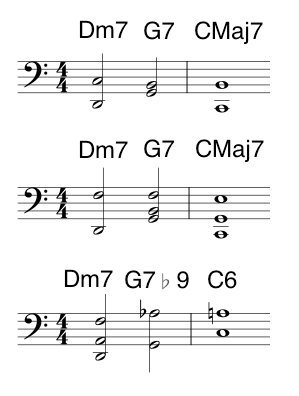Omitting Notes & Proto-Chords
In previous lessons we established that in Jazz we don’t need to play every single note in a chord. Specifically, it’s possible to omit the less important notes (root & 5th) to create a Shell Chord.
Well, Bud Powell Chord Voicings are also Shell Chords (they contain only two or three notes), but they always include the root (establishing the tonality of the chord). To facilitate this (and still keep it a Shell Chord) we drop either the 3rd or the 7th. This means you could argue that they are not ‘full and proper chords’ (much like the Thelonious Monk Voicings).
Bud Powell Chord Voicings, however, provide a strong sense of tonality precisely because they always include the root as the bottom note of the chord. And playing the root note of every chord as the bass note really spells out a chord progression.
Bud Powell Chord Voicings
Bud Powell Chord Voicings consist of:
- The root note; and
- Either the 3rd, 6th, 7th or 10th (a 3rd but an octave higher).
As an example, let’s take a II-V-I in C and play it using Bud Powell Chord Voicings (below).
| Chord | Notes | Sheet Music |
|---|---|---|
| Dm7 | D-C D-F D-A-F |  |
| G7 | G-B G-B-F G-A♭ |
|
| CMaj7 | C-B C-G-E C-A |
Chord Ambiguity
Because we are omitting notes each individual chord is ambiguous.
- The notes C & A could be: C6 or Am7 or FMaj7 or Dm7 or many other chords
However, because we are playing the root note of every chord as the bass note, the chord progression in it’s entirety is actually less ambiguous. This is because when we hear a bass-line moving through a well-known and obvious chord progression (like a II-V-I [D G C]; or the Cycle of Fifths [E A D G C]; or Chromatically [E E♭ D D♭ C]) our minds automatically fill in the gaps and hear the associated chords. The bass-line implies the chords.
Left Handed Voicing
Powell voicings are played entirely with the left hand. This means your right hand is free to play the melody or improvise. In future lessons we will also discuss numerous two handed chord voicings.
Jazz Piano History
This style of chord voicing was popular with Early Bebop Pianists. It was simple, sparse and easy to play. This was perfect for Bebop because Bebop solos were fast, busy and harmonically complex. The simplicity of the shell chords contrasted nicely with the complexity of the solos.
These voicings worked particularly well for Bebop because:
- They only contained two or three notes, which allowed the soloist to be more harmonically complex without clashing with the chord. The fewer notes you play, the fewer notes there are to clash with.
- They used large intervals (7ths & 10ths) which allowed the chord to be played in a low register without sounding muddy – which left the whole middle and upper register free for the soloist.
- They were easy to play at a fast tempo.
Have a Listen to
- Oh So Basal ~ Barry Harris
- Confirmation ~ Al Haig version
- Cherokee ~ Bud Powell version
- There will Never be Another You ~ Bud Powell version
- Any Early Bebop Piano